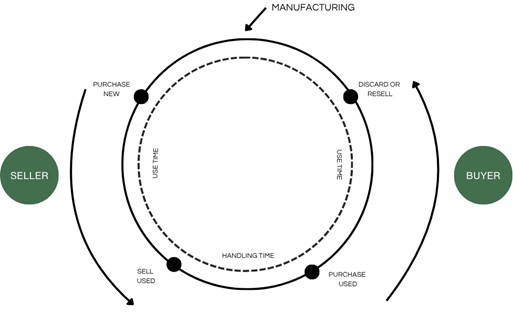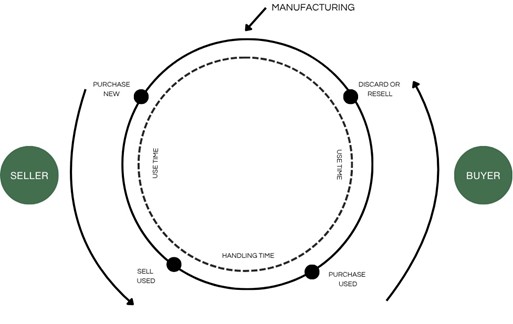A Multipersona Systemic Approach to the Integration of Secondhand Services in Manufacturing Brands


With a growing secondhand market (Statista, 2025) driven by changing consumer behaviour, manufacturing brands face the dual challenge of integrating secondhand sales and stock reacquisition within their new product sales and marketing strategies.
Many brands approach this by announcing the introduction of a new secondhand service, typically using generic messaging that treats all circular economy customers as a single group. However, this overlooks a crucial insight: customers do not engage with secondhand services holistically. Instead, they identify either as sellers or buyers and adopt these roles at specific times.
Drawing from my student collaboration with the Baltic2hand (Baltic2Hand, 2024) project and my recently completed thesis, which focused on addressing the circularity bottleneck produced by goods hibernation (Wilts et al. 2021), I argue that integrating circular services effectively requires a multipersona systemic approach. By recognizing and addressing the distinct mindsets of sellers and buyers, brands can design strategies that build stronger, more connected circular ecosystems.
The identity insight: sellers vs. buyers
A key finding from my thesis revealed that customers identify with specific roles at any given time, either as sellers or buyers of secondhand goods, rather than simultaneously occupying multiple roles (Alonso-Miranda, 2025).
Drawing on Self-Determination Theory (Ryan & Deci, 2020), which explains why people behave as they do, my research showed that the motivation driving seller behaviour differs fundamentally from that driving buyer behaviour. While the key needs of autonomy, competence, and relatedness are always present in individuals, their expression varies depending on the role adopted.
This distinction challenges an assumption that all customers interested in secondhand are equally interested in both selling and buying at the same time. Instead, it highlights the importance of (1) recognizing the different archetypes of customers who identify as sellers versus those who identify as buyers, and (2) understanding their different characteristics and needs as they move through these roles at different times.
The circular ecosystem through complementarity
In this systemic view, the circular journey or ecosystem is created through the complementarity of different personas rather than focusing on just one. For example, customers who identify as secondhand sellers typically purchase mainly new items and resell them. This is precisely where the journey of customers who identify as secondhand buyers begins. I visualized the journey in the graphic below:

The visualization presented above illustrates how sellers create the inventory that secondhand buyers seek, forming two complementary circular journeys that together form the ecosystem. Understanding this complementarity is particularly valuable for manufacturing brands that need to manage both new and secondhand sales channels simultaneously.
Practical implications
For manufacturing brands navigating the integration of circular services, this multipersona approach offers several practical advantages, specifically in the development of their marketing efforts and communication strategies. Rather than announcing a generic introduction of secondhand service, brands can target their efforts separately, with different content for sellers and buyers.
This separation allows brands to speak directly to each customer’s current mindset rather than diluting their message by trying to appeal to both simultaneously. A customer ready to sell isn’t thinking about buying, and vice versa.
As the secondhand market continues to grow, manufacturing brands have an opportunity to lead rather than react. A multipersona complementary approach provides a practical tool for strategic integration of circular services. By adopting a systemic view to circular integration, companies can create more effective strategies that acknowledge the complementary nature of different customers’ identities and roles, reduce barriers to participation, and ultimately build more robust circular ecosystems.
Raquel Alonso Miranda
Baltic2Hand project 2021-2027.
Ryan, R. M. & Deci, E. L. 2020-04. Intrinsic and extrinsic motivation from a self-determination theory perspective: Definitions, theory, practices, and future directions. Contemporary educational psychology, 61, p. 101860. doi:10.1016/j.cedpsych.2020.101860
Wilts, H., Fecke, M., & Zeher, C. 2021. Economics of Waste Prevention: Second-Hand Products in Germany. Economies, 9(2), 74. https://doi.org/10.3390/economies9020074
